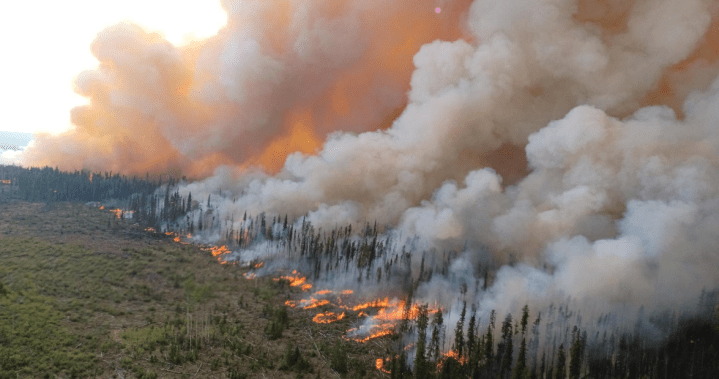Wildfire-detecting tech powered by Rogers 5G, SpaceX to be deployed in B.C. | Globalnews.ca
Firefighters in British Columbia will soon have access to early wildfire-detecting technology that uses 5G, artificial intelligence and satellites to spot emerging blazes long before the flames spread.
The first-in-Canada systems announced by Rogers on Thursday will connect Pano AI cameras that can detect smoke up to 20 kilometres away to 5G towers in northern B.C. communities. Rogers is also partnering with SpaceX to deploy satellite-connected sensors in remote areas of the province that can help predict wildfire activity.
The technology will be deployed “within the next few weeks,” said Neel Dayal, Rogers’ senior director of innovation and partnerships, and will be operational before the end of the year.
He told Global News in an interview the company hopes to deploy the technology across the country in the near future, as more Canadian provinces face the threat of wildfires.
“We have the connectivity and the power that’s required to effectively power these cameras (with our 5G towers), and we have many of those (towers) across the country that we can leverage to help combat this” wildfire threat, he said.
A Pano AI wildfire-detecting camera is mounted to a 5G tower on Signal Peak, Wash.
Courtesy of Pano AI
The announcement comes as B.C. and Canada continue to battle a record-shattering wildfire season.
To date, roughly 176,000 square kilometres have been burned across the country, including over 24,000 in B.C. alone.
Firefighters continue to battle more than 380 fires in B.C. and another 520 nationwide.
Dayal said Rogers first partnered with researchers at the University of British Columbia and the B.C. Wildfire Service in 2021 to explore pairing 5G technology with emerging technology like AI for early wildfire detection.
At that time, B.C. had just suffered its third-worst wildfire season on record, which burned just under 8,700 square kilometres.
Rogers and UBC have been working together since 2018 on exploring 5G capabilities, deploying low-power sensors in B.C. forests to monitor weather and fuel conditions and assess wildfire risk.
“These new technologies will expand the reach and capabilities of our existing network of 5G IoT sensors, giving us real-time data that can provide the foundation for an early warning system for wildfires and improve public safety,” Dr. Mathieu Bourbonnais, an assistant professor in environmental sciences at UBC Okanagan and a lead researcher for the Rogers 5G program, said in a statement.
The Pano AI cameras are being connected to 5G wireless towers near Fort St. James, Smithers and Chetwynd, B.C.
Each station includes two cameras mounted on a high vantage point, rotating at 360 degrees and connected to the company’s AI software.
Two Pano AI wildfire-detecting cameras are mounted to a 5G tower on Signal Peak, Wash.
Courtesy of Pano AI
The AI algorithm behind the camera would try to detect a plume of smoke and alert first responders early. The software is able to process images at a rapid pace to determine whether a plume is in fact smoke from a fire, as opposed to a cloud or mist hanging in the air or a dust cloud from a moving vehicle.
Pano cameras have already been deployed for wildfire detection in several western U.S. states — including Washington, Oregon, California and Colorado — using the T-Mobile 5G network. Both Pano and T-Mobile have pointed to the early detection of a wildfire in Oregon’s Mt. Hood National Forest in July as proof of the camera system’s efficacy.
Dayal said Rogers and its partners at UBC didn’t consult with T-Mobile to inform their work, but said the U.S. systems gave them “confidence” that they were on the right track.
“I think it provided some additional validation that 5G was a good enabling technology to this type of solution,” he said.
Rogers said it is also donating satellite phones to the British Columbia Search and Rescue Association to support first responders participating in wildfire response.
The satellite sensors will utilize SpaceX’s low-bandwidth Swarm service, which has already been used for satellite-to-phone coverage in remote parts of Canada.

Early wildfire detection is being increasingly embraced by researchers, private companies and governments as the fire threat continues to grow due to climate change.
The Canadian Space Agency, Canadian Forest Service, Canadian Centre for Mapping and Earth Observation and Environment and Climate Change Canada is set to launch WildfireSat, the world’s first purpose-build satellite for monitoring wildfires, in 2029.
AI-powered sensors are also being developed by researchers in the U.S. and Canada.
A United Nations report from 2022 found wildfires are becoming “more intense and more frequent” and said with temperatures on the rise as global warming worsens, “the need to reduce wildfire risk is more critical than ever.”
— with files from the Canadian Press and Associated Press
© 2023 Global News, a division of Corus Entertainment Inc.
For all the latest Technology News Click Here




